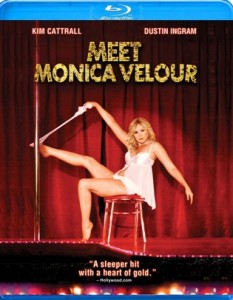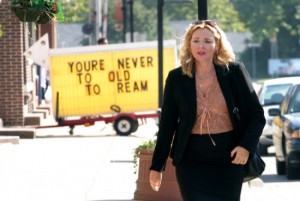 For his first feature film, writer/director Keith Bearden explore a decidedly less glamorous aspect of the world of adult entertainment–one that kicks in years after a porn starlet’s days of headlining have come to a close.
For his first feature film, writer/director Keith Bearden explore a decidedly less glamorous aspect of the world of adult entertainment–one that kicks in years after a porn starlet’s days of headlining have come to a close.
Meet Monica Velour (Blu-ray $34.99, DVD $29.98; Anchor Bay; released on Aug. 16, 2011) concerns a dweeby teenage boy named Tobe (Dustin Ingram), who sets out on a cross-country trip to meet his favorite 1980s’ porn star, Monica Velour (Kim Cattrall, Sex and the City), who’s making a rare live appearance. But Tobe is more than a little thrown when he meets the real Monica, a 49-year-old single mother who lives in a trailer in Indiana and strips in sleazy clubs to live from day to day.
Disc Dish spoke to Bearden about the movie,which is part comedy, part drama and, yes, part romance.
Disc Dish: I’m assuming you have an interest in adult entertainment as your feature film writing/directing debut is about an aging porn star.
Keith Bearden: I think that an adult film star is the ultimate modern celebrity. Just look at them: They’re very popular and everyone knows who they are for a time, but they never make a lot of money and then they fade away. Because we’re America, we have an expiration date on our women. So Monica, like real adult stars, becomes washed up. She slips away and no one bemoans that her days are gone.
DD: The last 20 years have seen a lot of changes in adult entertainment — pornography — and how the public accesses it, watches it and is affected by it.
KB: Oh yes. Pornography, we love the entertainment of it, we love the “hot spot.” But the world’s changing so fast that we’re not really keeping tabs on the wreckage. Think about kids these days, let’s say boys. Their first image of a naked woman is not the girl next door, it’s something they see on the Internet or on video. Because kids are now are exposed to so much media, they can become much more affected and isolated.
DD: When did you first come up with the idea for the film?
KB: I wrote it six years ago. I wanted to write a first film that would be cheap to make and with a female lead who was funny.
DD: And did you have Kim Cattrall in mind for the movie from the outset?
KB: I didn’t think of anybody when I was writing it. Producers got the script to the big agencies and there was a lot of interest. Madonna, Courtney Love and Julianne Moore (Chloe) were all on the list. [Then] I got word that Kim Cattrall really wanted to meet with me about it.
 DD: You must have thought there was a certain symmetry to the possibility of Samantha from Sex and the City portraying a once-hot adult star.
DD: You must have thought there was a certain symmetry to the possibility of Samantha from Sex and the City portraying a once-hot adult star.
KB: I’ve never seen Sex and the City! But I watched all of Kim’s earlier films, Ticket to Heaven, Big Trouble in Little China, Porky’s. My big issue was that Kim looked too good. For Monica, I told her, you’ve got to look like you’ve gone to seed. I wanted her to gain a lot weight and she did, almost 20 pounds.
DD: I hope that was fun for her. I can’t imagine that losing that kind of weight was a barrel of laughs.
KB: It wasn’t just the weight: After we shot the film [a couple of years ago in the suburbs outside of Detroit, Michigan], Kim had to go to a chiropractor for a few weeks because of all the slouching she did while playing Monica. It actually screwed up her posture.
DD: Well, Kim really clicked as a 1980s porn legend who’s just trying to make ends meet 30 years after her star has faded. She gets to be funny and sexy and angry, but also very sad.
KB: It says a lot about our society when our fantasy figures are disposable. Everybody’s more disposable today, athletes, actors, porn stars. We don’t own our fantasies, so we’re ready to throw them away when we’re done appreciating them. We dispose of our history.

Keith Bearden’s every word is on the mark. Our kids today have heroes and heroines who are as transitory as the moon phases. Fad today, gone tomorrow. The internet has become their imagination and the cellphone message their communication. They imagine that the exposure by the so-called stars of their personal idiot-synchracies is the norm, and so our kids go out and experience everything early on and lay bare their souls in public on Facebook.
Someone once said, a long time ago, that innocence was lost. What an understatement! We now make movies with kids of 7 years old smooching and we think it’s cute.
Let me repeat Keith’s words again “…the world’s changing so fast that we’re not really keeping tabs on the wreckage.”